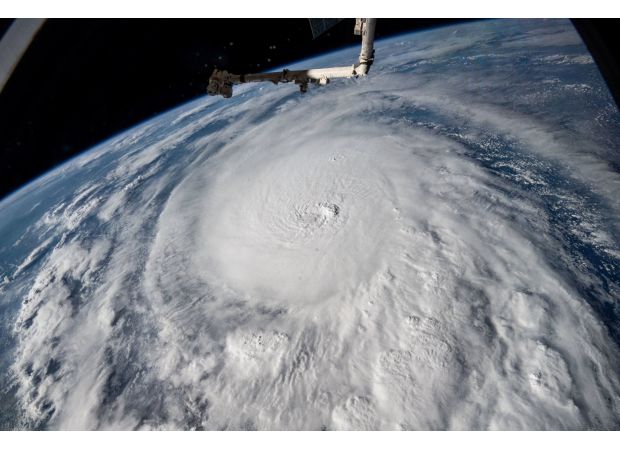Why are hurricanes getting stronger after Milton and Helene?
The increased intensity of rainfall and winds will lead to greater destruction.

The recent hurricane season has been one for the record books. Hurricane Milton, in particular, caught the attention of experts as it rapidly intensified into a Category 5 storm at an unprecedented speed. In fact, Milton was just one of many cyclones to wreak havoc in the Atlantic Ocean this season, with names like Alberto, Beryl, and Helene also making appearances.
As Hurricane Milton made its way towards Florida's Gulf Coast, residents braced themselves for the worst. And unfortunately, their fears were not unfounded. The storm caused widespread destruction, uprooting trees, ripping off roofs, and tragically claiming lives in a retirement home. Even after moving out to sea, Milton left behind a trail of destruction, with flash flood warnings in effect and a storm surge causing major concerns.
And as if one major hurricane wasn't enough, forecasters were already keeping an eye on Nadine, which could potentially become the next storm to hit the Atlantic. This raises the question: why are hurricanes becoming more intense? To understand this, we first need to understand what a hurricane actually is.
A hurricane is a type of tropical cyclone, a circular storm that forms over warm waters with low air pressure at its center and winds exceeding 74mph. However, hurricanes are only given this name if they form in specific regions, such as the North Atlantic, the northeastern Pacific, the Caribbean Sea, or the Gulf of Mexico. In other parts of the world, these cyclones are known by different names, such as typhoons in the northwest Pacific and tropical cyclones or cyclones in the southern hemisphere.
But what causes these destructive storms? According to the National Oceanic and Atmospheric Administration, most Atlantic hurricanes originate in Africa. As warm ocean waters and strong winds collide, the temperature difference between the air and the sea fuels the formation of these cyclones. Inside the storm, moisture evaporates and rises, creating a continuous cycle that helps keep the hurricane spinning. The Earth's rotation also plays a role in this process.
While hurricanes have always been a natural occurrence, the issue of climate change has raised concerns about their increasing intensity. It's not that climate change is directly causing more hurricanes, but the rising global temperatures are creating more favorable conditions for these storms to form. This is due to the increased amount of greenhouse gases in the atmosphere, which traps more heat and causes the air to hold more moisture. In fact, for every degree Celsius of warming, the air can hold 7% more water.
One climate expert noted that the heating of the ocean is a major factor in the increasing volatility of hurricanes. And Hurricane Milton, as it made landfall in Florida, certainly demonstrated the destructive power of a storm fueled by warmer waters. It even managed to shred the roof of Tropicana Field in St Petersburg.
In conclusion, hurricanes are a natural part of our world and serve a purpose in regulating our climate. However, the rising temperatures caused by factors like climate change are making these storms more intense and dangerous. As we continue to grapple with the effects of climate change, it's important to understand the role it plays in shaping these powerful natural disasters.
Hurricane Milton, the latest natural disaster to strike the Atlantic Ocean, has been making headlines as the fastest storm on record to intensify into a Category 5 hurricane. Along with other storms such as Alberto, Beryl, Chris, Debby, and Ernesto, Milton has caught the attention of experts who are surprised and worried by the sheer number of tropical cyclones that have occurred this hurricane season alone.
As Milton made its way towards Florida's Gulf Coast, it left a trail of destruction in its wake. Trees were uprooted, roofs were ripped off, and unfortunately, several people lost their lives in a retirement home. To add to the chaos, Milton also spawned tornadoes that caused even more damage. Although the storm has now moved out to sea, flash flood warnings have been issued due to the storm surge, which refers to the rise in water caused by strong winds pushing ocean water onto the shore.
The arrival of Hurricane Milton comes only weeks after another powerful storm, Helene, and forecasters are predicting that Nadine may also be on its way. This raises the question - why are hurricanes becoming more intense? To understand this, we must first understand what a hurricane is.
A hurricane is a type of tropical cyclone, a circular storm that forms over warm waters with low air pressure at its center and winds exceeding 74mph. However, hurricanes are only given this name if they form in specific regions, such as the North Atlantic, northeastern Pacific, Caribbean Sea, or the Gulf of Mexico. In other parts of the world, these storms are known as typhoons or cyclones.
So, what causes hurricanes to form? According to the National Oceanic and Atmospheric Administration, most Atlantic hurricanes can be traced back to Africa. As strong winds move over warm ocean waters, the temperature difference between the air and the sea creates the perfect conditions for a storm to develop. As the storm grows, moisture evaporates and rises, continuously sucking up warm air and spinning faster due to the Earth's rotation.
But how does climate change play a role in the intensity of hurricanes? While hurricanes themselves are a natural occurrence, the rising global temperatures caused by the burning of fossil fuels have led to an increase in the frequency and intensity of these storms. With every degree of warming, the atmosphere is able to hold 7% more water, making hurricanes even more destructive.
One climate expert suggests that the reason for the volatile nature of hurricanes is due to the warming of the ocean. This is evident in the case of Hurricane Milton, which made landfall in Florida yesterday with such force that it managed to shred the roof of Tropicana Field in St Petersburg.
As we continue to witness the devastating effects of hurricanes, it is important to remember that these storms play a crucial role in regulating the world's climate. However, with the continuous rise in global temperatures, it is imperative that we take steps to reduce our impact on the environment and mitigate the effects of climate change. As for the next Atlantic hurricane, it could be named Nadine, Oscar, Patty, Rafael, Sara, Tony, Valerie, or William, depending on where it forms.
16 Views






